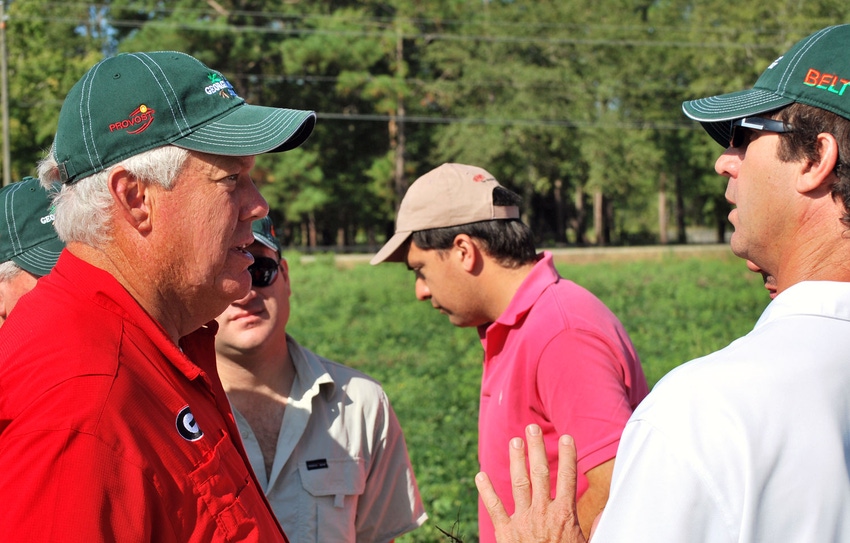
There is the science, but sometimes there is also the art when making recommendations as an Extension specialist. Along with teaching and research, Extension is at the heart of the land-grant universities. Extension takes pride in providing growers with research based, non-biased recommendations to help in making decisions needed for a profitable harvest.
Extension specialists in the Southeast have collectively addressed many important issues to help establish best management practices. As a team, we have tackled target spot, bacterial blight, seedling diseases, nematodes and cotton leafroll dwarf virus in cotton, rust, taproot decline, and cyst nematodes in soybeans, and leaf spot, southern stem rot, and tomato spotted wilt to further the impact of Peanut Rx.
As our industry partners, commodity commissions and organizations such as the National Peanut Board and Cotton, Inc. have recognized, the most comprehensive advances in disease and nematode management often result from these united efforts.
Given these team efforts, some ask, “Bob, if you are all working on the same problems, why is it that management recommendations may vary from specialist to specialist?” On a more personal note, I still occasionally hear, “That’s not what Boyd Padgett used to tell us." Dr. Padgett left the University of Georgia over 20 years ago. More recently, I hear, “That’s great, Bob, but Tom Allen over in Mississippi is telling his growers something different."
Extension is nothing without integrity and clarity in our recommendations. But because of this, Extension recommendations for disease and nematode management sometimes differ between states and specialists but are important.
No. 1 - Passage of time
Though Dr. Padgett left UGA Extension a long time ago, growers remember him fondly and they remember what he taught them. That my recommendations vary from recommendations made “back in the day” are the result of new varieties, new fungicides and nematicides, advances in research and perhaps new diseases.
No. 2 - Differences in geography
Where recommendations differ between states, reasons are frequently linked to variability in the threat of diseases or nematodes based upon soil types, weather patterns, cropping systems, growing season, popular varieties, etc. For example, the southern root-knot and sting nematodes are more problematic in Georgia’s cotton fields, while the reniform nematode is more common in Alabama and the panhandle of Florida.
Areolate mildew and target spot are more often threats to cotton in Georgia than they are in Mississippi.
Cercospora leaf blight may be a greater threat to soybeans in Louisiana than in Georgia, but soybean rust is a greater threat in Georgia than it is in Arkansas.
Peanut growers in Florida may battle southern stem rot, locally known as “white mold” while peanut farmers in North Carolina and Virginia may battle Sclerotinia blight, locally known there as “white mold”.
No. 3 - Grower experience
Row crop farmers in Georgia are quite familiar with the use of fungicides on their crops, likely because many of them grow peanuts. In Georgia’s peanut production, consistent yields and greatest profit are often achieved with multiple fungicide applications. Confidence in the value of fungicides coupled with availability of sprayers easily translates into use of fungicides on other crops as well. Recommendations for expanded use of fungicides may be more restricted in areas where growers have used them less often.
No. 4 - Personal experience
Recommendations are often part science, part experience and part “art." For example, I tend to be more aggressive in the use of fungicides on corn than other specialists may be. Perhaps this is because Georgia’s corn growers are at greater risk to southern corn rust than may be corn growers elsewhere. Also, over 21 years at the University of Georgia, some of my biggest mistakes have occurred when I was timid in recommending use of a fungicide for fear of spending a grower’s money.
There have been a few times when that fear led to a timid recommendation that came back to haunt me. Especially when there is not as much research data as we would like, or where there is conflicting data, some specialists may make more aggressive recommendations and while others may be more hesitant to “pull the trigger”. For better or worse, from my experiences I am often a “trigger puller”.
Talking it out
Ideally, recommendations are based on thorough review of complete data sets. In such cases, differences between one state and another are typically linked to varying levels of risk depending on environment, cropping history and grower expectations.
Sometimes, as in new situations or where there is less data than we might like experience and art are essential to finding a best answer. While our recommendations in such instances may differ, you can bet that Trey Price, Travis Faske, Ed Sikora, Heather Young, Nick Dufault, Dan Anco, David Langston, Amanda Scherer, Tom Allen, and I are all talking to each other.
About the Author(s)
You May Also Like






